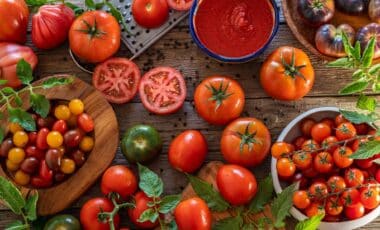“Posada” in Spanish means shelter, and it tells the Biblical story of Mary and Joseph’s journey to Bethlehem.They are an important Mexican tradition that takes place nine nights leading up to Christmas (December 16-24), involving many iconic customs such as pinatas and asking for shelter via song. Find out what exactly comprises a posada, so you can have your own pre-Christmas celebration this month.
1. Asking For Shelter

“Singing for shelter” (Graphic: Courtesy of Paola Dávila)
A traditional posada song has two parts. Some people will stand outside the house and sing the part where Joseph is asking for shelter, while others will be inside the house singing the role of the innkeeper who famously informs Joesph that there is no availability. In Mexico, people will typically hold candles while doing this, as a symbol of the light from the star that guided Joseph and Mary on the auspicious night. The song goes back and forth a few times until the innkeeper finally agrees to let them in.
2. Food

“Tamales, buñuelos and hot punch” (Graphic: Courtesy of Paola Dávila)
Like with every Mexican celebration, food plays a big part. It’s tradition to have a family dinner late on Christmas Eve. You can add a Mexican touch to your Christmas Eve dinner by including some of these dishes:
- Tamales: Cornmeal dumplings wrapped in corn husks or banana leafs and steamed. They can be filled with different salty or sweet ingredients.
- Bacalao: A dried salted codfish dish of European origin. Mexicans adopted this delicacy after Spain conquered the country centuries ago. The most popular way to prepare it is stewed with tomatoes, capers, olives and potatoes—“Bacalao a la Vizcaina”.
- Ponche: This hot fruit punch is made with tejocotes, guava, apple, plum and many other fruits. It is flavoured with cinnamon and piloncillo, and you can add a splash of brandy to make it even more tasty!
- Romeritos: A small green wild plant that is served with shrimp cakes and doused in sweet mole.
3. Piñatas & Flare Lights

“Piñata, dale dale” (Graphic: Courtesy of Paola Dávila)
Piñatas and flare lights are two of the things that children love the most about Posadas. Traditionally made of paper mache and clay, nowadays people get cardboard piñatas to make sure no one gets hurt once they breaks. Piñatas are filled with fruit and people take turns hitting them with a stick until they breaks open. Usually, piñatas will have a star shape with seven points, representing the seven deadly sins. Beating the piñata open represents fighting sins, and the fruits represent the reward for fighting the evil.
(See also: The World’s Best Christmas Markets, According To Travel Experts)







